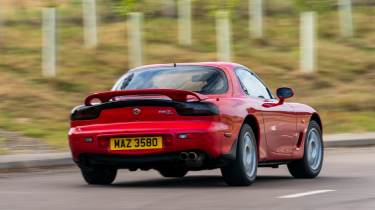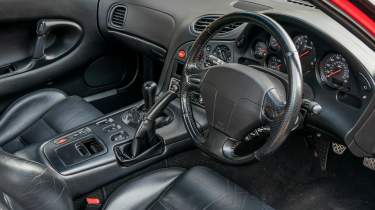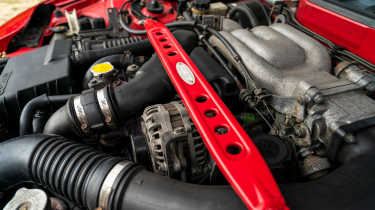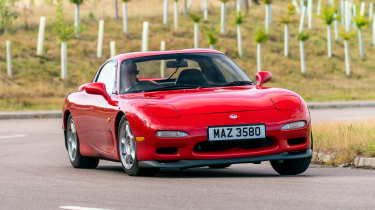Mazda RX-7 FD (1992 - 2002): a '90s Japanese icon
The third-generation Mazda RX-7 was one of the sharpest coupes of the ’90s
In Mazda’s lineup, the RX badge means only one thing: a rotary engine. The badge was first applied to the compact RX-2 family car in 1970, but since 1978 it’s been most closely associated with the brand’s flagship sports car, the RX-7 – and the one that arguably defines the breed, the third generation ‘FD’ RX-7 produced between 1992 and 2002.
Mazda’s final RX-7 was developed at the height of Japan’s booming economy in the late 1980s, and put all of Mazda’s engineering knowledge to the fore. More compact and lighter than its predecessor, it also featured the latest development of the brand’s twin-rotor engine, dubbed the 13B-REW.
With twin sequential turbochargers, and positioned as low and far back as Mazda could put it in a new stiffer, lighter chassis, the 237bhp coupe could compete toe-to-toe with more powerful rivals such as the Toyota Supra, Honda NSX and Nissan Skyline GT-R.
The RX-7 sold poorly in the UK when new, but its numbers today have been bolstered by an influx of Japanese imports. The vast majority have been modified, influenced by Japan’s tuning culture and the RX-7’s numerous appearances in racing games and on the silver screen, but even a factory-fresh original car is still a pleasure both to look at and to drive.
Mazda RX-7 in detail
RX-7 ownership isn’t without its caveats – this is a car that needs regular, careful maintenance to remain healthy, plus a near-religious approach to oil changes and warm-up procedures, and all but the most meticulously maintained cars will likely need an engine rebuild at some point, as Mazda never quite solved the problem of the engine’s rotor tip seals wearing away. Find a good one though, and you’ll get to enjoy one of the best cars Japan has ever made.
More reviews
The RX-7 was sold across three generations during its production run. The first arrived in 1978, and was known as the SA22C from 1978 until 1980, and given the FB designation from 1981 until its replacement by the second-generation car in 1985. These early RX-7s set the tone for the model, with a compact two-door coupe body style, a twin-rotor engine positioned behind the front axle line, and drive to the rear wheels.
While the early RX-7 didn’t make much of a splash in the UK, it proved enormously popular in the United States, Australia, and Japan, and Mazda sold nearly half a million during the car’s seven-year run. Its 1985 follow-up, given the FC designation, was more advanced, offered greater performance, and was a larger car, but the price also increased, and by the time it bowed out in 1992, it had sold just over 270,000 units globally.
The third-generation RX-7 was an altogether more serious car. Designed in Mazda’s California studio – by a team including Tom Matano, who had worked on the original MX-5 that debuted in 1989 – the new ‘FD’ RX-7’s styling shed the FC’s boxy 1980 lines for exotic curves, and a more tightly-packaged shape that was shorter, but wider and lower than its predecessor.
Central to the new car was a newfound obsession with weight-saving, and at its lightest the new FD actually undercut the FC’s kerb weight, despite it packing a new twin sequential turbocharged twin-rotor engine, known as the 13B-REW. The engine had made its debut in Japan’s exotic Cosmo luxury coupe but in the RX-7, attached to a five-speed manual transmission and Torsen limited-slip differential, UK-spec cars could get from 0-62mph in 5.3sec.
The twin turbochargers also endowed the RX-7 with a unique character, and by the standards of the 1990s, minimal turbo lag. The first turbocharger delivered its power from around 2500rpm, while a complex system of vacuum lines got the second turbo spinning up in the background. From around 4500rpm a valve opens allowing the second turbo to contribute, and the engine delivers its full boost. UK cars developed 237bhp at 6500rpm, with a redline at 7000, but the rotary will happily (and smoothly) spin beyond this point, even as a buzzer reminds you to change up…
In America and Japan, the RX-7 gained even more power, with later Japanese cars making a full 276bhp, on paper at least – this was of course the time where Japanese brands still at least pretended to observe a gentleman’s agreement on limiting power.
The chassis meanwhile was as close as you were likely to find to the sports car ideal at the time. Mazda used forged aluminium double wishbones both front and rear, as well as aluminium hub supports, while some of the suspension components used spherical bushes. Subframes were rigidly mounted to the body and Mazda fitted bracing underneath to firm up the steel monocoque.
While the structure was steel, Mazda used aluminium extensively, from the bonnet to bumper supports, to the space saver spare wheel and the jack. Even the brake and clutch pedal were drilled aluminium items, saving half a kilo over steel equivalents. The car’s physically small size was all part of Mazda’s weight-reduction efforts too – with smaller windows than its predecessor, Mazda saved 9kg from the windscreen alone, while each door assembly was 6kg less than that in the FC.
In its ten years on sale, Mazda produced fewer than 70,000 FD RX-7s, in contrast to the huge sales of its predecessor. A much higher price undoubtedly played a part: in the UK, the RX-7 originally started at around £32,000, the equivalent of around £68,000 in 2024. Sales were dreadful, despite the RX-7’s launch coming just a year after the brand’s historic win at the 1991 Le Mans 24 Hours, and Mazda quickly dropped the price down to £25,000. In the end, Mazda UK sold only a few hundred to UK buyers, and the car was quietly dropped in 1995. It continued on in Japan, with small developments every couple of years, until 2002.
| Mazda RX-7 (1992) | |
| Engine | 654cc x2, rotary, twin-turbo |
| Max power | 237bhp @ 6500rpm |
| Max torque | 218lb ft @ 5000rpm |
| Weight | 1310kg |
| Power-to-weight | 181bhp/ton |
| 0-60mph | 5.3sec (claimed) |
| Top speed | 156mph (limited) |
Mazda RX-7 FD review
I can still remember the last time I drove a third-generation, ‘FD’ RX-7. But that’s because it was also the first time. It was way back in 1993, when the car was new and causing a stir in the UK. There was a real buzz about it, and I’m not just talking about its audible rev limiter. Even those who would not normally be drawn to Japanese performance cars found the fast and voluptuous rotary-powered Mazda very hard to ignore.
The same was true of Toyota’s bewinged A80 twin-turbo Toyota Supra and Nissan’s slightly more discreet, but no less appealing, 300ZX. That this was also the heyday for Honda’s NSX makes it clear how strong the Japanese brands were in the early to mid ’90s. Factor in BMW’s equally fresh E36 M3 and Porsche’s 968 and you’ll appreciate this was something of a golden era for fans of fast, front-engined and relatively affordable rear-drive coupes.
As you’d expect from Mazda, the RX-7 was the oddball of the bunch, courtesy of its twin-turbo 13B-REW Wankel engine. With twin rotor chambers (each displacing 654cc) and turbo equivalency applied, the RX-7 was deemed to have a 2.6-litre motor. The unit’s compact size and light weight made it easy to package behind the front axle line and low in the chassis for a 50:50 weight distribution and low centre of gravity.
> Mazda MX-5 review: a breath of fresh air in 2024
Mazda RX-7: twin-turbo Wankel rotary engine
The engine was unusual for its use of twin sequential turbos. Indeed, it was amongst the first of its kind. The concept was simple, the first turbo boosting from 2000rpm, with exhaust gases then fed directly from it into the second, identically sized, turbo to further reduce lag. It was an effective, if complex system that relied on precise electronic control of boost pressures to work seamlessly.
Like all cars of this era, the RX-7 seems so small and compact. It might be small, but its curves (evolved from a concept penned by Mazda’s US design studio) ensure it has plenty of presence. It’s funny, though, how your mind plays tricks; cars that you thought looked low and wide and had big wheels don’t actually look that spectacular these days. No wonder, when a quick glance at the pretty five-spoke rims shows they’re only 16 inches in diameter and wrapped in 225/50 rubber. No matter, for the innate rightness of the shape and the courage of the design mean the FD’s looks remain surprisingly avant-garde.
There wasn’t really anything like it before, and there hasn’t been anything quite like it since. The smoked, one-piece, full-width tail light still makes a dramatic statement, while the pop-up headlights are proper ’90s nostalgia. They were actually a necessity due to the low-line nature of the RX-7’s nose.
The door handle is positioned unusually high, up above the waistline and nestled against the B-pillar. You open the door expecting the glass to be frameless, but instead you find a heavy black surround framing the side-glass lenses like a pair of thick-rimmed spectacles. The interior mirrors the exterior with its organic curves, but advances in materials mean the RX-7’s black-plastic cockpit has dated badly. It doesn’t feel that great quality-wise, but it’s a comfortable place to be thanks to squidgy seats that yield nicely, allowing you to sink into them for support.
You don’t sit as low as you might expect, and the steering wheel is quite big in diameter with proud stitching that also features on the handbrake and gearknob. Equipment levels are pretty basic by today’s standards – leather upholstery, a pair of plastic luggage bins instead of rear seats, air conditioning, electric windows, powered mirrors and a stereo are all there is to shout about. The instruments are simple but really quite handsome, with a bold typeface, a speedo that reads to 180mph and a tacho that reads round to 9000rpm, even though the red line itself starts at an altogether more modest 7000rpm. Gauges for oil pressure, oil temperature and fuel level sit to the left of the tacho to complete a proudly analogue binnacle.
The view though the windscreen is dominated by curves, the rising line of each extremity swooping up towards you while each door mirror captures a reflection of the long arc of the door tops that flow into the rear wheelarches. Everywhere you look, sections of the RX-7’s fulsome shape swell into view to remind you you’re driving something special.
Mazda RX-7: on the road
The engine starts with a characteristic chunter before settling into a rapid idle, rotary tips whizzing round at a busy and rorty 2500rpm for a minute or two before the revs eventually settle down. The clutch is modestly weighty; the throttle has a nice measured resistance. The stubby gearlever hints at a snappy, short-throw gearshift that’s clean and accurate, but the first few miles reveal the five-speed transmission is blessed with a good rather than brilliant shift.
The steering weight is more substantial than I was expecting, and that’s a welcome surprise, for it confirms the sense that the RX-7 is a communicative car with well-matched control efforts and carefully measured responses. The cast-aluminium pedals look attractive, feel good under your feet and are widely spaced across the footwell. The relationship between brake and throttle was clearly signed off by someone who enjoyed heel-and-toe work, and the exhaust is soon popping and crackling nicely with each easily blipped downshift.
Of course, the 13B motor was what made the RX-7 unique amongst its contemporary rivals, and it’s what continues to add curiosity value today. The engineering differences between rotary and conventional internal combustion engines might be large, but the tangible differences from behind the wheel are surprisingly subtle. Yes, of course that has something to do with the motor not being in a screaming state of tune, unlike in the legendary Mazda race cars, but it also shows that while rotary engines are still seen as eccentric, they are impressively straightforward in the way they go about their business.
This car has an aftermarket exhaust, which is a bit more vocal than an OE system, but strip away the snorty soundtrack and you find an engine blessed with refinement and good manners. Rise through the revs and it has a finely serrated smoothness that confounds your senses and encourages you to work it hard. It’s a genuinely enjoyable engine; torquey with little lag, it delivers a solid shove from 3000rpm through to 6000rpm. Beyond that it runs out of puff a bit, yet still pulls meaningfully to the red line – signalled by the infamous buzzer as a reminder to take another gear. If you’re remotely intrigued by a car’s oily bits, the RX-7’s motor is special. It doesn’t dominate the whole character of the car, but it asserts itself nicely and sets the tone for a driving experience that’s outside the norm but delivers the goods.
This particular car has clearly lived a life, one in which it has covered more than 90,000 miles. That said, while the dampers and bushes aren’t in their first flushes of youth, and despite the front axle running on a different brand of tyre to the rear, it still manages to feel tidy. It rides with pliancy, masking minor surface imperfections and absorbing potholes without too much fuss, though there are a few creaks from the interior plastics! More impressive is the way the innate balance of this front-mid-engined, rear-drive chassis shines through, and how you rapidly build a clear picture of the sharpness and agility for which the third-gen RX-7 was rightly praised when new.
Funnily enough, of the memories I have of my first drive in an FD RX-7 back in 1993, the most lasting impression is of a car that demanded respect – something the 22-year-old me had just enough of to keep the Mazda out of the weeds. One moment in particular sticks in my mind. The road was damp and chased across hilly terrain. Travelling at enthusiastic but not silly speed, the RX-7 squeezed into a gently curving compression. As the suspension got towards the bottom of its travel, the vertical and lateral loads pushed the tail out of line with little warning. It was one of those moments caught by luck and youthful, sparky synapses rather than sage car control, not least because these were the days when I was testing my own limits as much as those of the car. It certainly taught me a lesson.
My driving skills – and judgement – have come a long way in the last 20 years, but I still can’t help but feel a little wary of this old Mazda for the first few miles. The nicely weighted steering is complemented by a calm rate of response that’s typical for fast cars of this era (just under three turns lock to lock) and which makes it easy to confidently place the RX-7 in corners with intuitive precision. You need only encourage it into long curves with a small squeeze of steering input, then relax the lock as the corner opens out. It finds a very satisfying and easily sustained flow.
The balance is beautifully neutral, with just enough bite from the front tyres to generate decent grip and response but not enough to induce oversteer. Likewise, the rear end has strong traction – not a surprise given the rear tyres aren’t exactly over-burdened with torque. In short, the perfect weight distribution and sweet ratio of grunt to grip ensures a harmony that lets the chassis work unhindered by dynamic imbalance. That it’s not fighting with an engine that’s too potent underlines the fact that sometimes less really is more.
Carry meaningful speed into a second- or third-gear corner, chase the throttle from apex to exit, and you feel the car and its Torsen limited-slip diff load up nicely, sitting down on the outside rear as the loads increase and those sequential turbos start to blow. It’s at this point I feel something of the RX-7 I recall, for when pushed hard it rapidly makes the transition from just on the limit to some way over it. It’s fun and harmless enough in the dry, but I can clearly see how I nearly came unstuck all those years ago.
The brakes are up to the job of fast road driving, with progressive response, but they don’t have the capabilities of those on today’s high-performance cars, so you have to be a little sympathetic. You’d toast them on track, but then cars of this age weren’t developed with as much in reserve as today’s performance models.
It’s been great to be reacquainted with the FD RX-7. Three decades of rampant engineering progress and sky-rocketing performance mean Mazda’s flagship sports car is no longer the force it was back in 1993, but it remains a thoroughly charming, fascinating, intriguing and usefully rapid car. It does things differently – as you’d hope – but it does them well. Well enough to remain the high point for Mazda’s rotary efforts. Here’s hoping last year’s glorious RX-Vision concept makes the leap to production and rekindles some of this RX-7’s abundant magic.







